Mises, Ludwig von. Human Action: A Treatise on Economics
Подождите немного. Документ загружается.

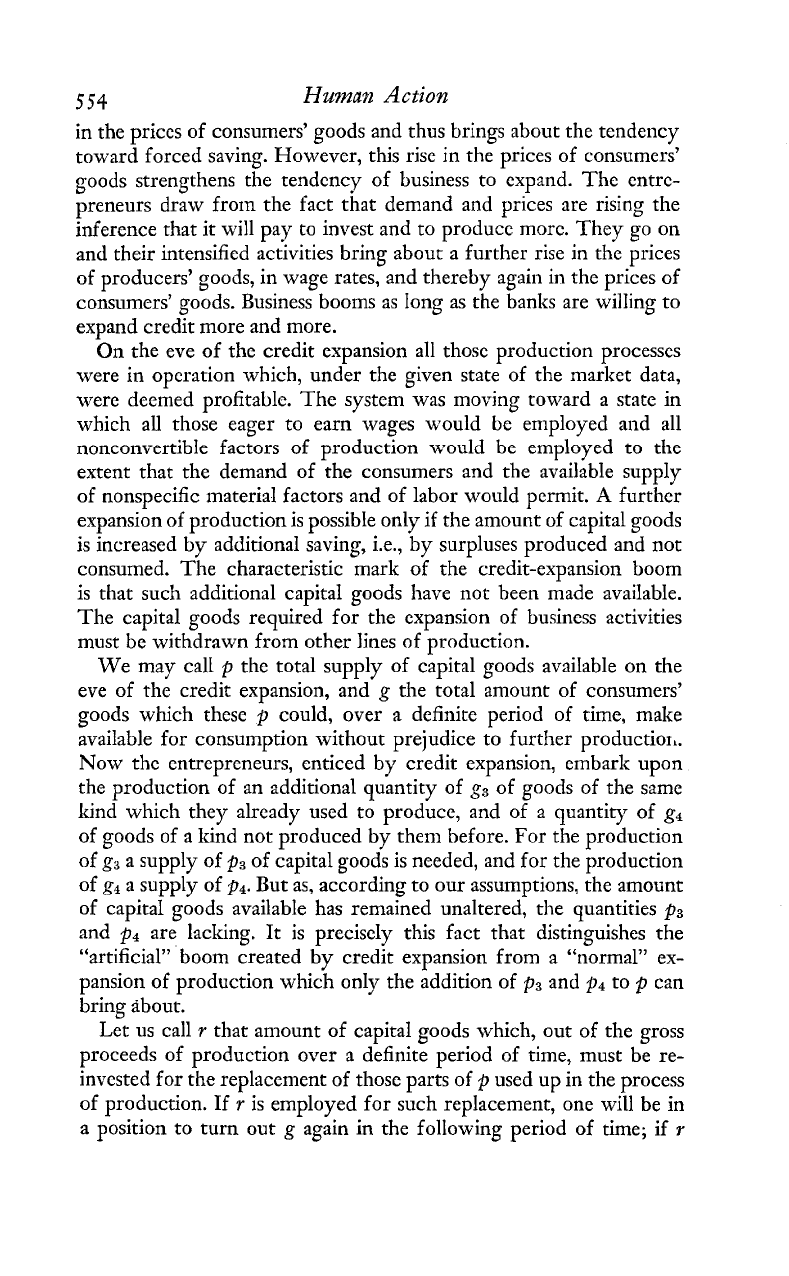
5
54
Human
Action
in the prices of consumers' goods and thus brings about the tendency
toward forced saving. However, this rise in the prices of consumers'
goods strengthens the tendency of business to expand. The entrc-
preneurs draw from the fact that demand and prices are rising the
inference that it will pay to invest and to produce morc. They go on
and their intensified activities bring about a further rise in the prices
of producers' goods, in wage rates, and thereby again in the prices of
consumcrs' goods. Business boom as long as the banks are willing to
expand credit more and more.
On the eve of the credit expansion all thosc production processes
were in opcration which, under the given state of the market data,
were deemed profitablc. The system was moving toward a state in
which all those eager to earn wages would be enlployed and all
nonconvertible factors of production would be employed to the
extent that the demand of the consumers and the available supply
of nonspecific material factors and of labor would permit.
A
further
expansion of production is possible only
if
the amount of capital goods
is increased by additional saving, i.e., by surpluses produced and not
consumed. The characteristic mark of the credit-expansion boom
is that such additional capital goods have not been made available.
The capital goods required for the expansion of business activities
must be withdrawn from other lines of production.
We
may calI
p
the total supply of capital goods available on the
eve of the credit expansion, and
g
the total amount of consumers'
goods which these
p
could, over a definite period of time, make
available for consumption without prejudice to further productior,.
Now thc entrepreneurs, enticed by credit expansion, embark upon
the production of an additional quantity of
g3
of goods of the same
kind which they already used to produce, and of a quantity of
g4
of goods of a kind not produced by then1 before. For the production
of
g,
a
supply of
p3
of capital goods is needed, and for the production
of
g4
a supply of
p4.
But as, according to our assumptions, the amount
of capita1 goods available has remained unaltered, the quantities
f13
and
p4
are lacking.
It
is preciscly this fact that distinguishes the
"artificial" boom created
by
credit expansion from a "normal" ex-
pansion of production which only the addition of
pa
and
p4
to
p
can
bring about.
Let us call
r
that amount of capital goods which, out of the gross
proceeds of production over a definite period of time, must be re-
invested for the replacement of those parts of
p
used up in the process
of production. If
r
is employed for such replacement, one will be in
a position to turn out
g
again in the following period of time; if
r
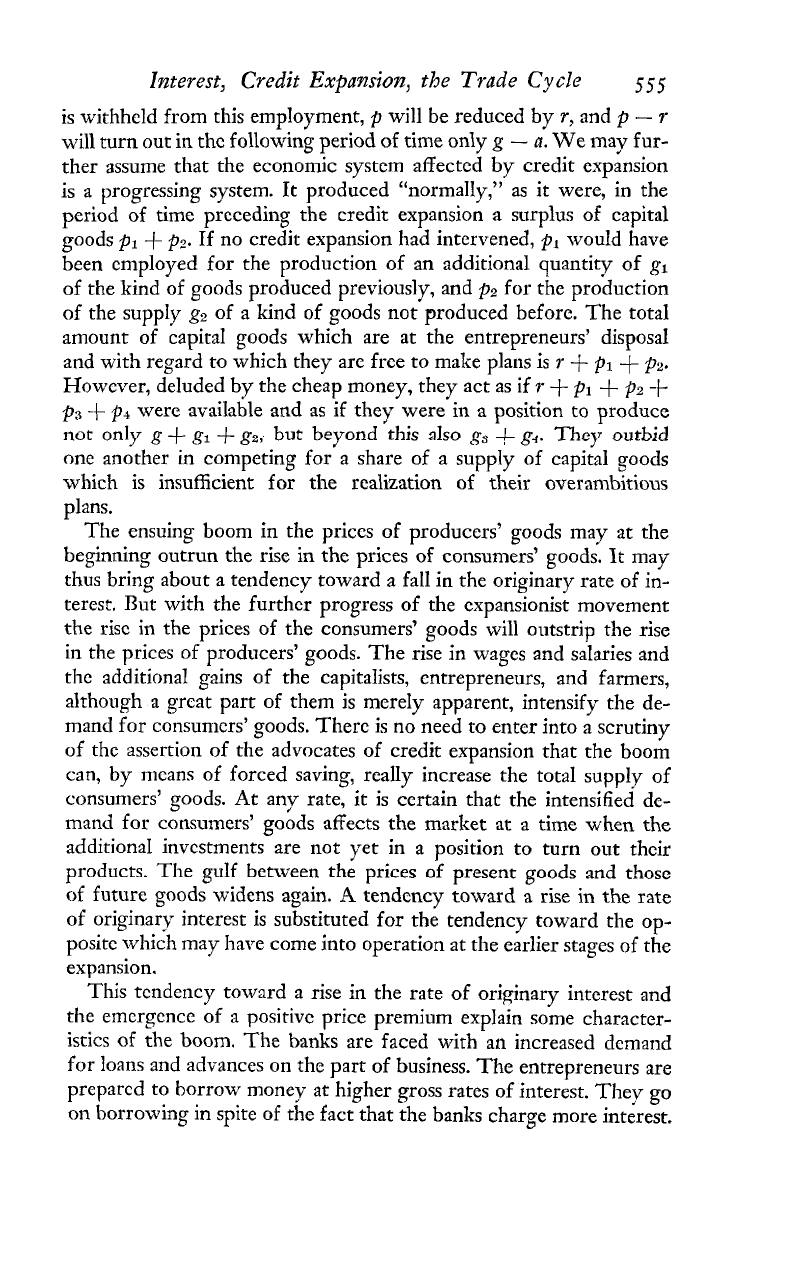
Interest, Credit Expansion,
the
Trade
Cycle
j
55
is withheld from this employment,
p
will be reduced by
r,
and
p
-
r
will
turn out in thc following period of time only
g
-
a.
We may fur-
ther assume that the economic system affected by credit expansion
is a progressing system. It produced "normally," as it were, in the
period of time preceding the credit expansion a surplus of capital
goods
pl
+
p2.
If no credit expansion had intervened,
p,
would have
been employed for the production of an additional quantity of
g.1
of the kind of goods produced previously, and
p2
for the prdduction
of the supply
g,
of a kind of goods not produced before. The total
amount of capital goods which are at the entrepreneurs' disposal
and with regard to which they are frce to make plans is
r
+
pl
+
p,.
However, deluded by the cheap money, they act as if
r
+
p,
+
pz
-+
p:)
-+-
p4
were available and as if they were in a position to produce
not only
g
+
gl
f
g2,
but
beyond this also
g~
+
G.
They outbid
one another in competing for a share of a supply of capital goods
which is insufficient
for
the realization of their overambitious
plans.
The ensuing boom in the prices of producers' goods may at the
beginning outrun the rise in the prices of consumers' goods. It may
thus bring about a tendency toward
a
fall in the originary rate of in-
terest. But with the further progress of the expansionist movement
the rise in the prices of the consumers' goods will outstrip the rise
in the prices of producers' goods. The rise in wages and salaries and
the additional gains of the capitalists, entrepreneurs, and farmers,
although a grcat part of them is merely apparent, intensify the de-
mand for consumers' goods. There is no need to enter into a scrutiny
of thc assertion of the advocates of credit expansion that the boom
can, by mcans of forced saving, really increase the total supply of
consumers' goods. At any rate, it is certain that the intensified de-
mand for consumers' goods affects the market at a time when the
additional
investments
are not yet in a position to turn out their
products. The
gulf
between the prices of present goods and those
of future goods widens again.
A
tendency toward
a
rise
in
the rate
of originary interest is substituted for the tendency toward the op-
posite which may have come into operation at the earlier stages of the
expansion.
This tcndency toward a rise in the rate of originary interest and
the emergence of
a
positive price premium explain some character-
istics of the boom. The banks are faced with an increased demand
for loans and advances on the part of business. The entrepreneurs are
prepared to borrow money at higher gross rates of interest. They go
on borrowing in spite of the fact that the banks charge more interest.
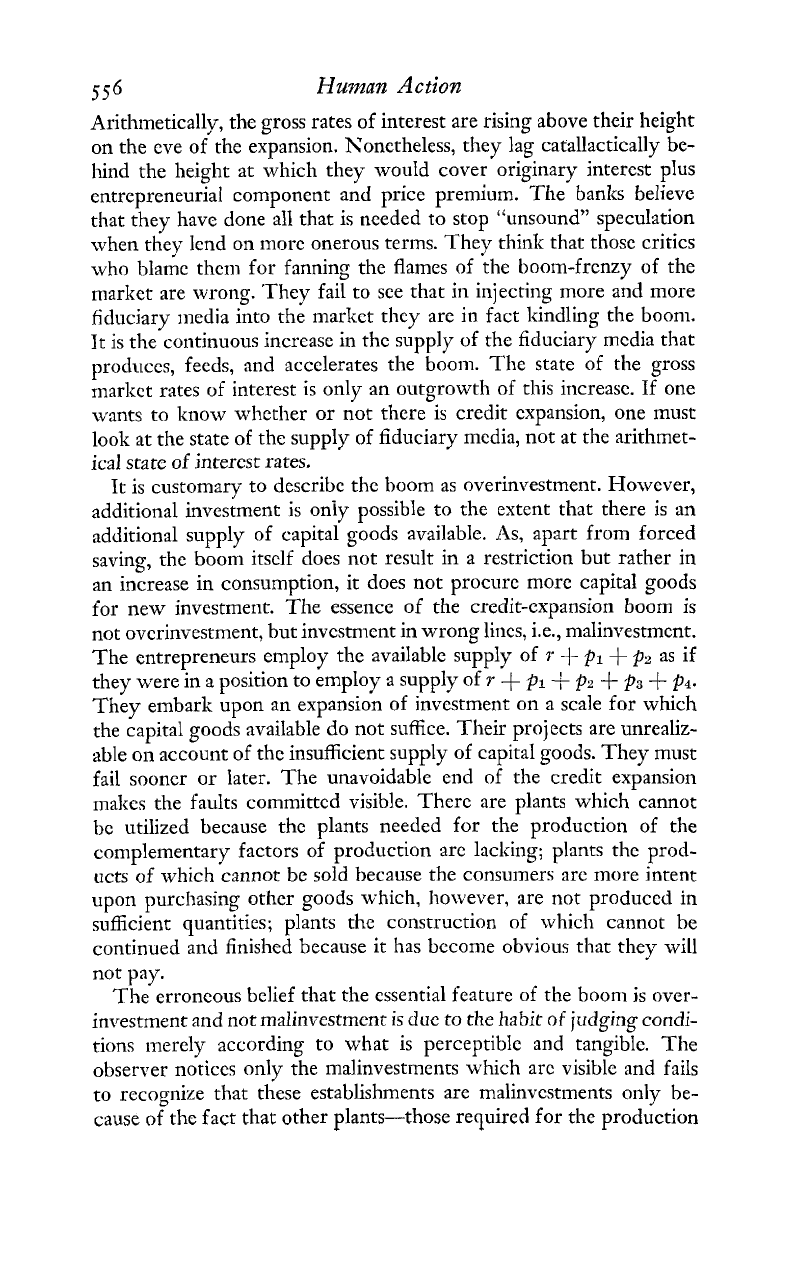
556
Human
Action
Arithmetically, the gross rates of interest are rising above their height
on the eve of the expansion. Konetheless, they lag catallactically
be-
hind the height at which they would cover originary interest plus
entrepreneurial component and price premium. The banks believe
that they have done a11 that is needed to stop "unsound" speculation
when they lend on more onerous terms. They think that those critics
who blame them for fanning the flames of ;he boom-frenzy of the
market are wrong. 'They fail to see that
in
injecting more and more
fiduciary media into the market they are in fact kindling the boom.
It is the continuous increase in the supply of the fiduciary media that
produces, feeds, and accelerates the boom. The state of the gross
rnarltct rates
of
interest is only an outgrowth of this increase. If one
wants to know whether or not there is credit expansion, one must
look at the state of the supply of fiduciary media, not at the arithmet-
ical state of interest rates.
It is customary to describe the boom as overinvestment. However,
additional investment is oniy possible to the extent that there is an
additional supply of capital goods available. As, apart from forced
saving, the boom itself does not result in a restriction but rather in
an increase in consumption, it does not procure more capital goods
for new investment. The essence of the credit-expansion boom
is
not overinvestment, but invcstment in wrong lines, i.e., malinvestmcnt.
The entrepreneurs employ the available supply of
1.
-4-
p,
+
pa
as if
they were in a position to employ a supply of
r +
PI+
p,
f
p,
+
p4.
They embark upon an expansion of invcstment on a scale for which
the capital goods available do not suffice. Their projects arc unrealiz-
able on account of the insufficient supply of capital goods. They must
fail sooner or later. The unavoidable end of the credit expansion
rnalrcs the faults committed visible. There are plants which cannot
be
utilized because the plants needed for the production of the
complementary factors of production are lacking; plants the prod-
ucts of which cannot be sold because the consumers arc more intent
upon purchasing other goods which, however, are not produced in
sufficient quantities; plants the construction of n~hich cannot be
continued and finished because it has become obvious that they will
not pay.
The erroneous belief that the essential feature of the boom is over-
investment and not malinvestment
is
due to the habit of judging condi-
tions merely according to what is perceptible and tangible. The
observer notices only the malinvestments which are visible and fails
to recognize that these establishments are malinvestments only be-
cause of the fact that other plants-those required for the production
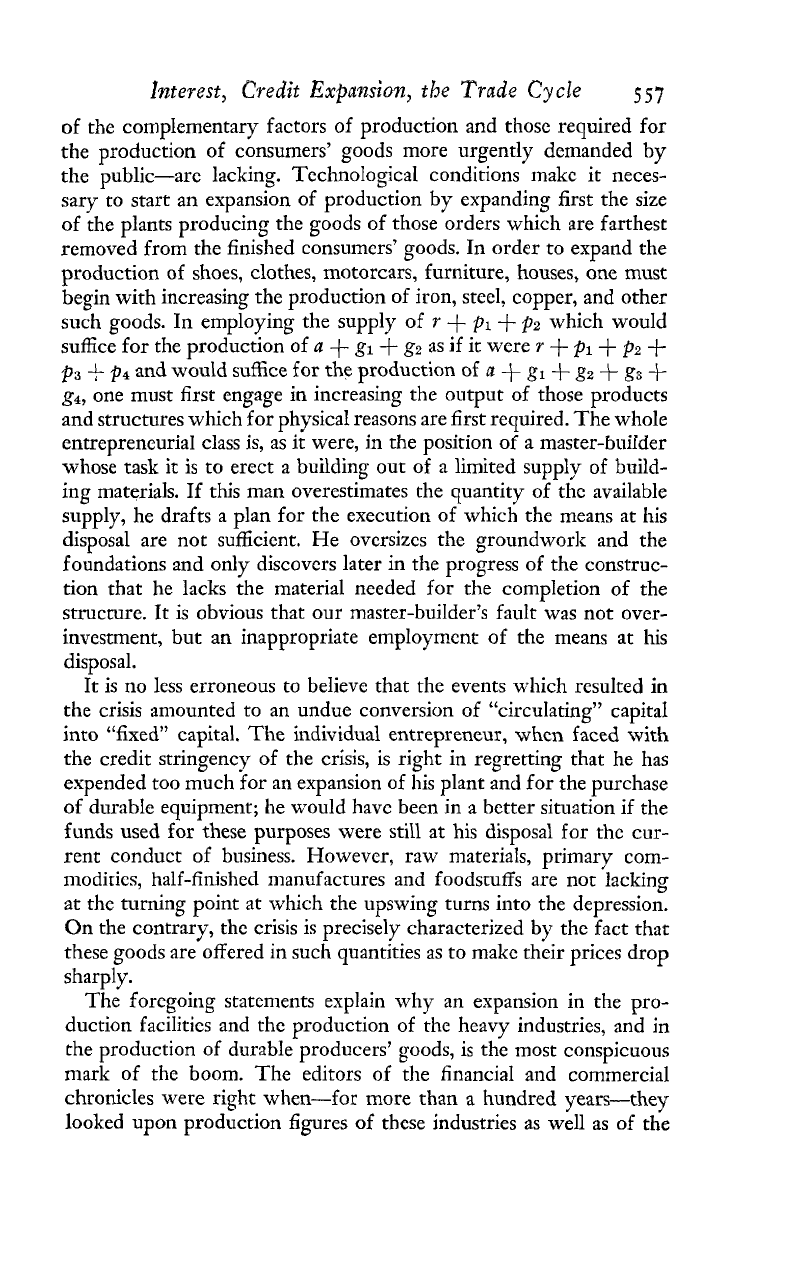
Interest, Credit Expansion, the Trade Cycle
557
of the complementary factors of production and those required for
the production of consumers7 goods more urgently demanded
by
the public-are lacking. TechnoIogical conditions rnakc it neces-
sary to start an expansion of production by expanding first the size
of the plants producing the goods of those orders which are farthest
removed from the finished consumers' goods. In order to expand the
production of shoes, clothes, motorcars, furniture, houses, one must
begin with increasing the production of iron, steel, copper, and other
such goods. In employing the supply of
r
+
PI
+
p~
which would
suEce for the production of
a
+
g1+
g2
as if it were
r
+
pl
+
p2
f
p3
+
p4
and would suffice for the production of
a
+
gl
+
g,
+
g,
$-
g4,
one must first engage in increasing the output of those products
and structures which for physical reasons are first required. The whole
entrepreneurial class
is,
as it were, jn the position of a master-builder
whose task it is to erect a building out of a limited supply of build-
ing materials. If this man overestimates the quantity of the available
supply, he drafts a plan for the execution of which the means at his
disposal are not sufficicnt. He ovcrsizcs the groundwork and the
foundations and only discovers later in the progress of the construc-
tion that he lacks the material needed for the completion of the
struccure. It is obvious that our master-builder's fault was not over-
investment, but an inappropriate employment of the means at his
disposal.
It is no less erroneous to believe that the events which resulted in
the crisis amounted to an undue conversion of "circulating" capital
into "fixed" capital. The individual entrepreneur, when faced with
the credit stringency of the crisis, is right in regretting that he has
expended too much ?or an expansion of his plant and for the purchase
of durable equipment; he would have been in
a
better situation if the
funds used for these purposes were still at his disposal for the cur-
rent conduct of business. However, raw materiaIs, primary com-
rnoditics, half-finished manufactures and foodstuffs are not lacking
at the turning point at which the upswing turns into the depression.
On the contrary, the crisis
is
precisely characterized by the fact that
these goods are offered in such quantities as to make their prices drop
sharply.
The foregoing statements explain why an expansion in the pro-
duction facilities and the production of the heavy industries, and in
the production of durable producers7 goods, is the most conspicuous
mark of the boom. The editors of the financial and commercial
chronicles were right when-for more than a hundred years-they
looked upon production figures of these industries as well as of the
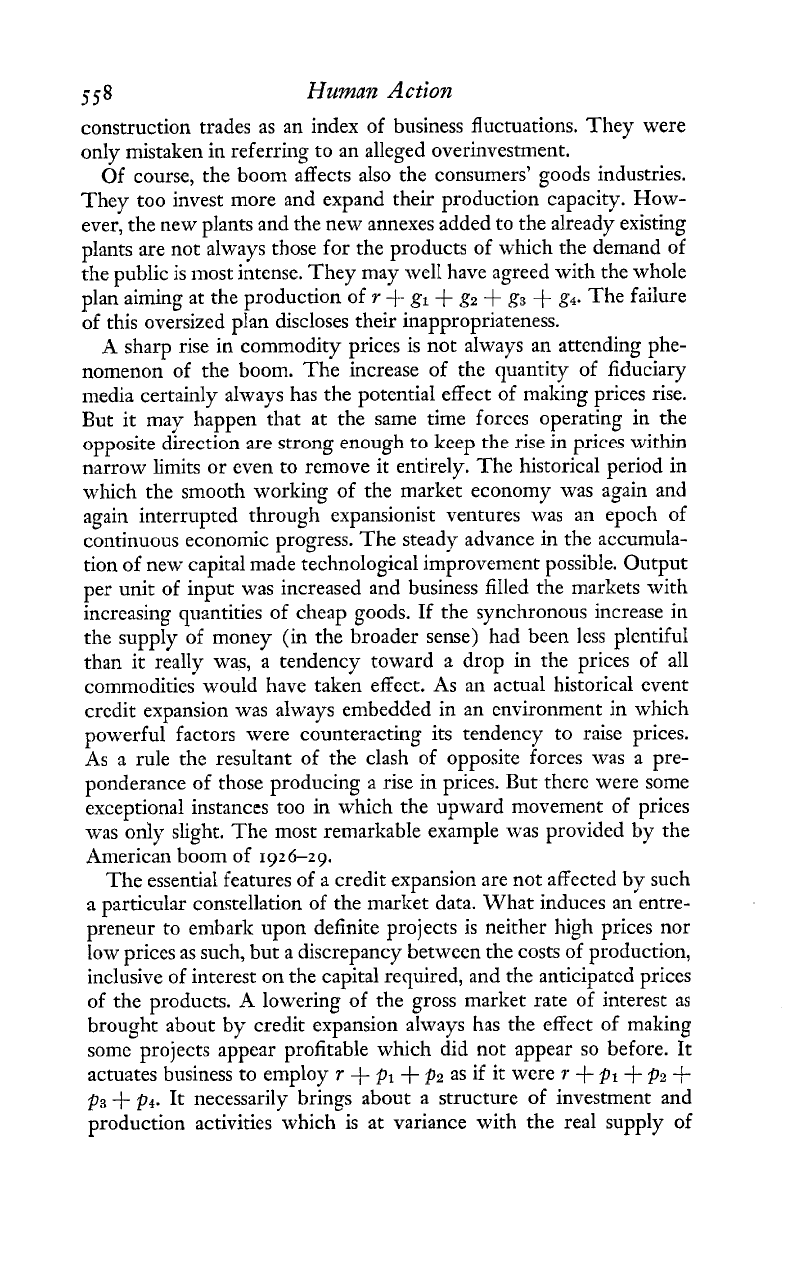
558
Human
Action
construction trades as an index of business fluctuations. They were
only mistaken in referring to an alleged overinvestment.
Of course, the boom affects also the consumers' goods industries.
They too invest more and expand their production capacity. How-
ever, the new plants and the new annexes added to the already existing
plants are not always those for the products of which the demand of
the public is most intense. They may we11 have agreed with the whole
plan aiming at the production of
r
$-
g,
+
.g2
$
g3
$-
g4.
The failure
of this oversized plan discloses their inappropriateness.
A sharp rise in commodity prices is not always an attending phe-
nomenon of the boom. The increase of the quantity of fiduciary
media certainly always has the potential effect of making prices rise.
But it may happen that at the same time forces operating in the
opposite direction are strong enough to keep the rise in prices within
narrow limits or even to remove it entirely. The historical period in
which the smooth working of the market economy was again and
again interrupted through expansionist ventures was an epoch of
continuous economic progress. The steady advance in the accumula-
tion of new capital made technological improvement possible. Output
per unit of input was increased and business fiIled the markets with
increasing quantities of cheap goods. If the synchronous increase in
the supply of money (in the broader sense) had been less plentiful
than it really was, a tendency toward a drop in the prices of all
commodities would have taken effect. As an actual historical event
credit expansion was always embedded in an environment in which
powerful factors were counteracting its tendency to raise prices.
As a rule the resultant of the clash of opposite forces was a pre-
ponderance of those producing a rise in prices. But thcrc were some
exceptional instances too in which the upward movement of prices
was only slight. The most remarkable example was provided by the
American boom of
I~zG-29.
The essential features of a credit expansion are not affected by such
a
particular constellation of the market data. What induces an entre-
preneur to embark upon definite projects is neither high prices nor
low prices as such, but a discrepancy between the costs of production,
inclusive of interest on the capital required, and the anticipatcd prices
of the products.
A
lowering of the gross market rate of interest as
brought about by credit expansion always has the effect of making
some projects appear profitable which did not appear so before. It
actuates business to employ
r
+
pl
+
pz
as if it were
r
+
PI+
pz
+
p3
+
p,.
It necessarily brings about a structure of investment and
production activities which is at variance with the real supply of
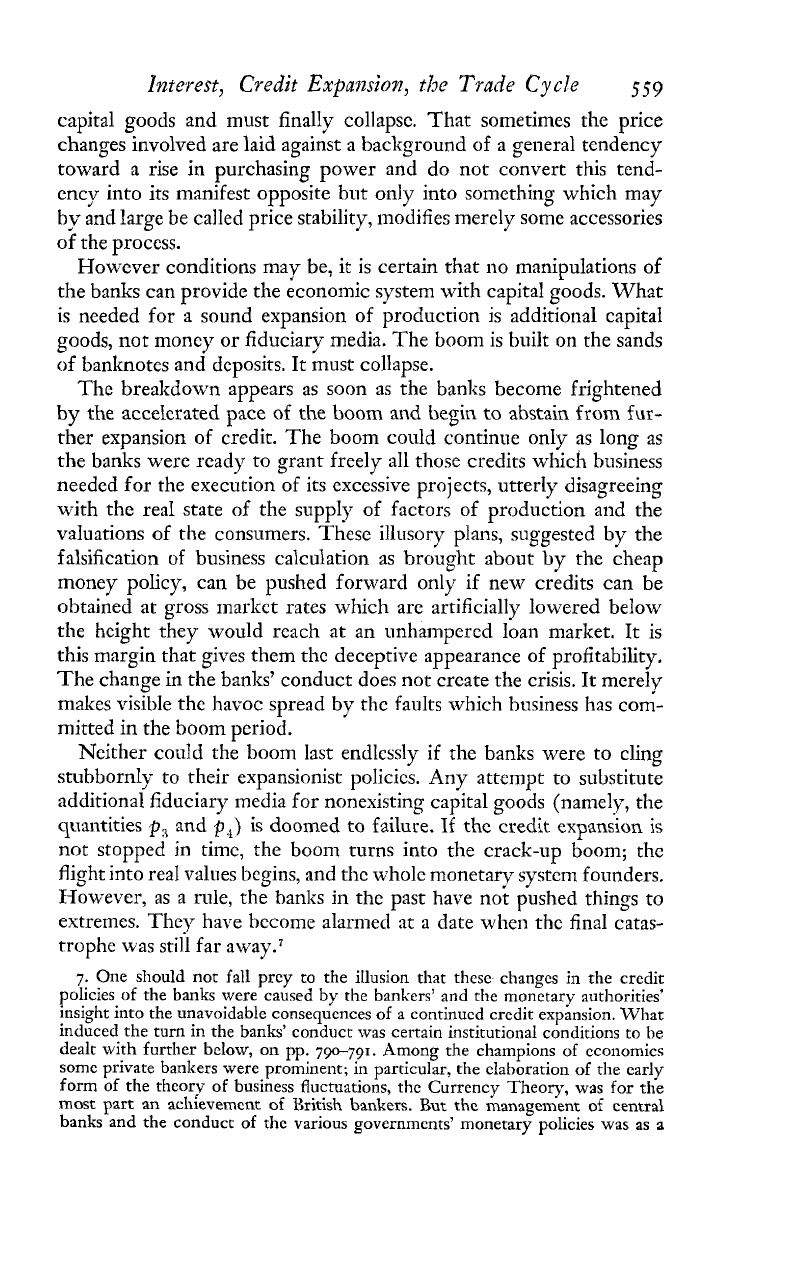
Interest, Credit
Expansion,
the
Trade Cycle
559
capital goods and must finally collapse. That sometimes the price
changes involved are laid against a background
of
a general tendency
toward a rise in purchasing power and do not convert this tend-
ency into its ~nanifest opposite but only into something which may
bv
and large be called price stability, modifies merely some accessories
oi the process.
However conditions may be, it is certain that no manipulations of
the banks can provide the economic system with capital goods. What
is needed for a sound expansion of production is additional capital
goods, not money or fiduciary media. The boom is built on the sands
of banknotes and deposits. It must collapse.
The breakdown appears as soon as the banks become frightened
by
the accelerated pace of the boom
and
begin to abstain from fur-
ther expansion of credit. The boom could continue only as long as
the banks were ready to grant freely all those credits which business
needed for the execition of its excessive projects, utterly disagreeing
with the red state of the supply of factors of production and the
valuations of the consumers. These illusory plans, suggested by the
falsification of business calculation as brought about by the cheap
money policy, can be pushed forward only if new credits can be
obtained at gross rnarket rates which are artificially lowered below
the height they would reach at an unhampered loan market. It is
this margin that gives them the deceptive appearance of profitability.
The change in the banks' conduct does not create the crisis. It merely
makes visible the havoc spread by the faults which business has com-
mitted in the boom period.
Neither couId the boom last endlessly if the banks were to cling
stubbornly to their expansionist policics. Any attempt to substitute
additional fiduciary media for nonexisting capital goods (namely, the
qtmtities
p,
and
p,i)
is doomed to failure. If the credit
expanu&n
is
not stopped in timc, the boom turns into the crack-up boom; the
flight into real values begins, and the whole monetary system founders.
However, as
a
rule, the banks in the past have not pushed things to
extremes. They have become alarmed at a date
when
the final catas-
trophe was still far away.?
7.
One sllould not fall prey to the illusion that these changes in the credit
policies of the banks were caused by the bankers' and the monetary authorities'
insight into the unavoidable consequences of a continued credit expansion. What
induced the turn in the banks' conduct was certain institutional conditions to
be
dealt with further below, on pp.
790-791.
Among the champions of
economics
some private bankers were prominent; in particular, the elaboration of the early
form of the theory of business fluctuations, the Currency Theory, was for the
most part an achievement
of
British bankers.
But
the management of central
banks and the conduct of the various governments' monetary policies was as
a
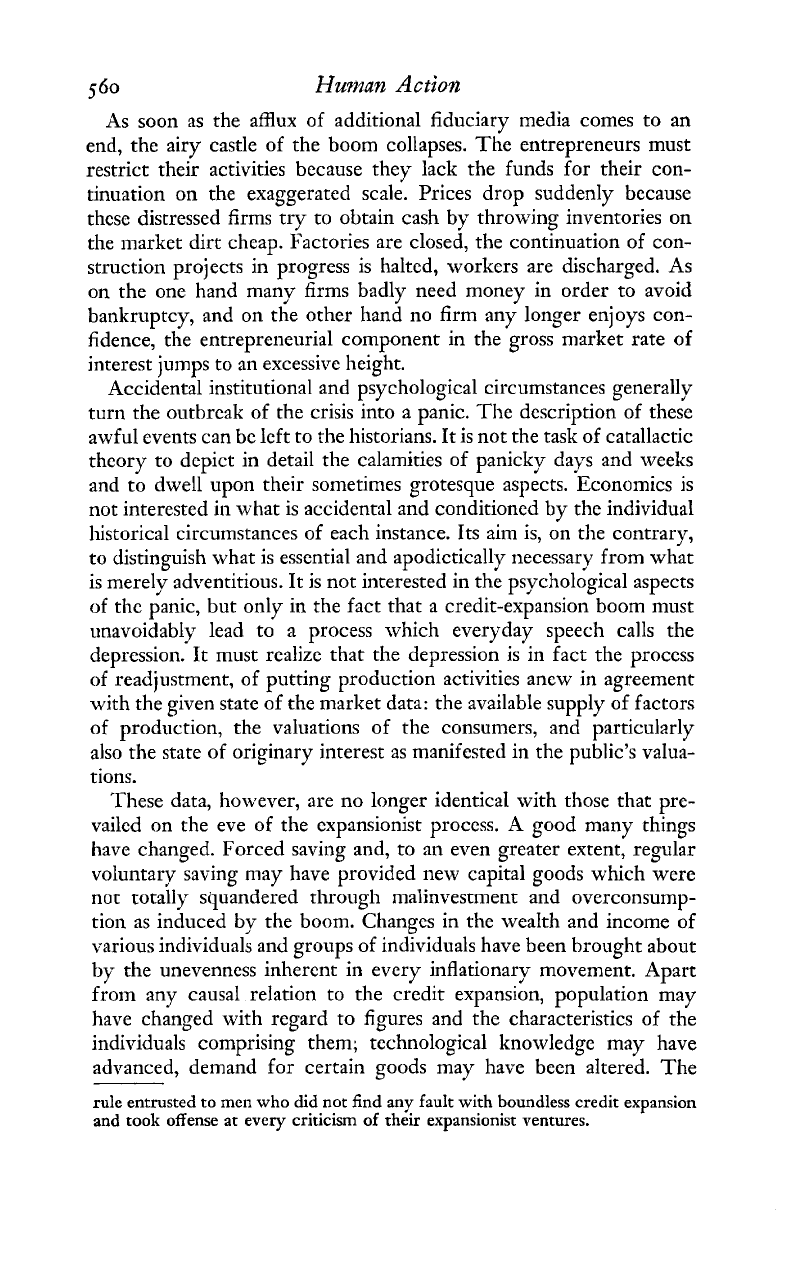
As soon as the afflux of additional fiduciary media comes to an
end, the airy castle of the boom collapses. The entrepreneurs must
restrict their activities because they lack the funds for their con-
tinuation on the exaggerated scale. Prices drop suddenly because
these distressed firms try to obtain cash by throwing inventories on
the market dirt cheap. Factories are closed, the continuation of con-
struction projects in progress is halted, workers are discharged. As
on the one hand many firms badly need money in order to avoid
bankruptcy, and on the other hand no firm any longer enjoys con-
fidence, the entrepreneurial component in the gross market rate of
interest jumps to an excessive height.
Accidental institutional and psychological circumstances generally
turn the outbreak of the crisis into a panic. The description of these
awful events can be left to the historians. It is not the task of catallactic
theory to depict in detail the calamities of panicky days and weeks
and to dwell upon their sometimes grotesque aspects. Economics is
not interested in what is accidental and conditioned by the individual
historical circumstances of each instance. Its aim is, on the contrary,
to distinguish what is essential and apodictically necessary from what
is merely adventitious. It is not interested in the psychological aspects
of the panic, but only in the fact that a credit-expansion boom must
unavoidably lead to a process which everyday speech calls the
depression. It must realize that the depression is in fact the process
of readjustment, of putting production activities anew in agreement
with the given state of the market data: the available supply
of
factors
of production, the valuations of the consumers, and particularly
also the state of originary interest as manifested in the public's valua-
tions.
'These data, however, are no longer identical with those that pre-
vailed on the eve of the expansionist process. A good many things
have changed. Forced saving and, to an even greater extent, regular
voluntary saving may have provided new capital goods which were
not totaiiy squandered rhrough maiinvestment and overconsump-
tion as induced by the boom. Changes in the weaIth and income of
various individuals and groups of individuals have been brought about
by the unevenness inherent in every inflationary movement. Apart
from any causal relation to the credit expansion, population may
have changed with regard to figures and the characteristics of the
individuals comprising them; technological knowledge may have
advanced, demand for certain goods may have been altered. The
rule entrusted to men who did not find any
fault
with boundless credit expansion
and took offense at every criticism of their expansionist ventures.
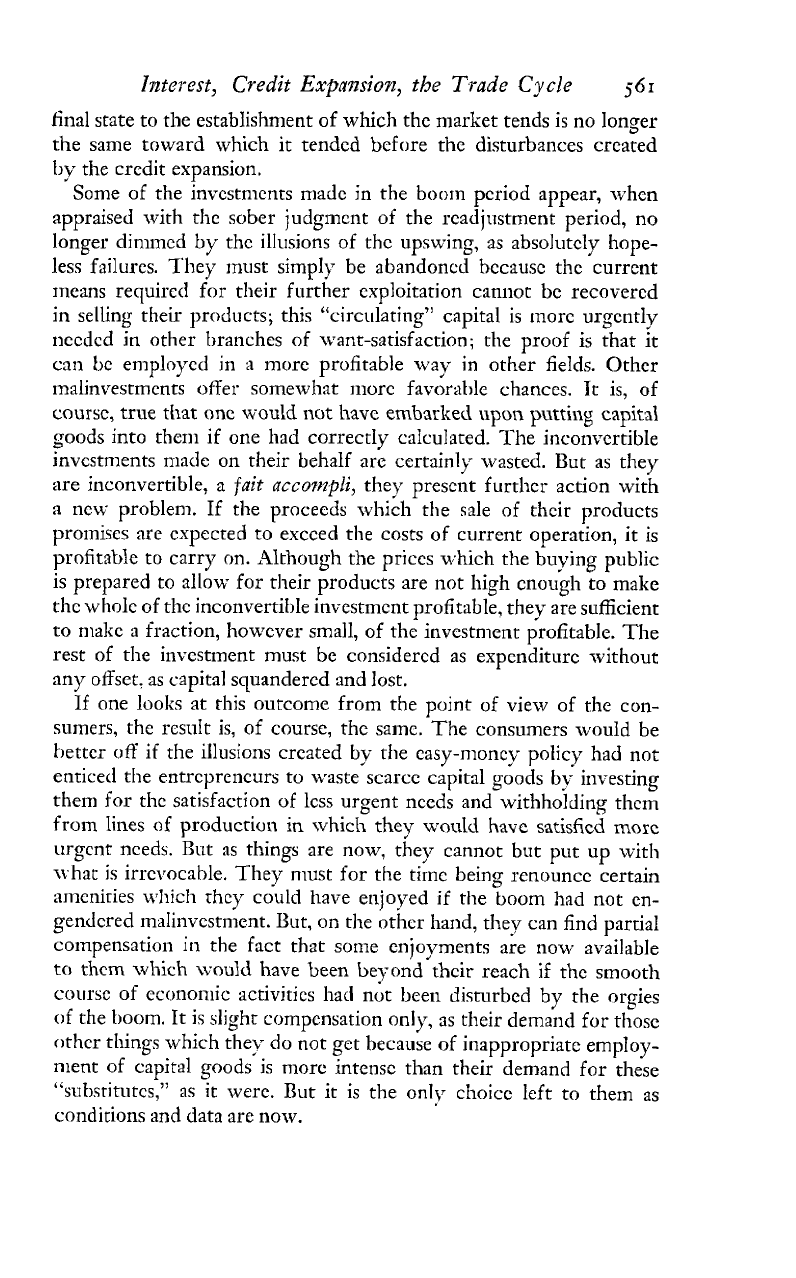
Interest,
Credit
Expnnsion, the
Trade
Cycle
j6
I
final state to the establishnient of which the market tends is no longer
the same toward which it tended bcfore thc disturbances created
by the credit expansion.
Some of the invcstnicnts niadc jn the boom period appear, whcn
appraised with the sober judgment of the rcadjmtment period, no
longer din~ncd
by
thc illusions of thc upswing, as
absolutely
hope-
less failures. They must simply be abandoned hecausc thc current
rneans requircd for their further exploitation cannot be recovered
in selling their products; this "circulatiug" capital is rnorc urgently
11ecdcd in other branches of want-satisfaction; the proof
is
that it
can t)c employed in
a
more profitable way in other fields. Other
~nalinvestmcnts offer somewhat more favoratrlc chances.
Tt
is, of
course, true that one would not have embarked
upon
pntting capital
goods into thcm if one had correctly calculated. The
inconvertible
invcstnlents niade on their behalf are certainly wastcd. But as they
are inconvertible,
a
fait
accowzpli,
they prescnt further action with
a
ncw problem. If the proceeds which the sale of thcir products
promises are expected to exceed the costs of current operation, it is
profitable
to carry
on.
Although the prices ~.hich the
buving
public
is prepared to allow for their products are not high cno@h to make
thc whole of thc inconvertible investmcnt profitable, they are sufficient
to make a fraction, hou~cver small, of the investment profitable. The
rest of the investment must be considercd as expenditure without
any offset. as capital squandercd and lost.
If
one looks at this outcome from the point of view of the con-
sumers, the rcsnIt is, of course, thc same. The consumers would be
[letter
off
if the iIlusions created by the casy-moncy policy had not
emiced the entrcprencurs to waste scarce capital goods
by
investing
them for the satisfaction of lcss urgent needs and withholding thcm
from lines
of
production
in
which they
would
have
satisfied
more
urgent nceds. But as things are now, they cannot but put
up
with
u
hat is irrevocable. They must for the tirnc being rcnouncc certain
amenities which thcy c;uld have enjoyed
if
the boom had not en-
gendcred rnalinvcstment. But,
on
the othcr hand, thev can find partial
compensation in the fact that some enjoyments aie now available
to
thcm
which
would have been beyond thcir reach
if
the smooth
course of cconomic activitics had n& been disturbed
by
the orgies
of
the boom. It is slight
compensation
only, as their demand for those
other things which the); do not get because of inappropriate empIoy-
nlent of capital goods is more intensc than their demand for these
"s~htitutcs," as it were. But it is the only choicc left to thern as
conditions and data are now.
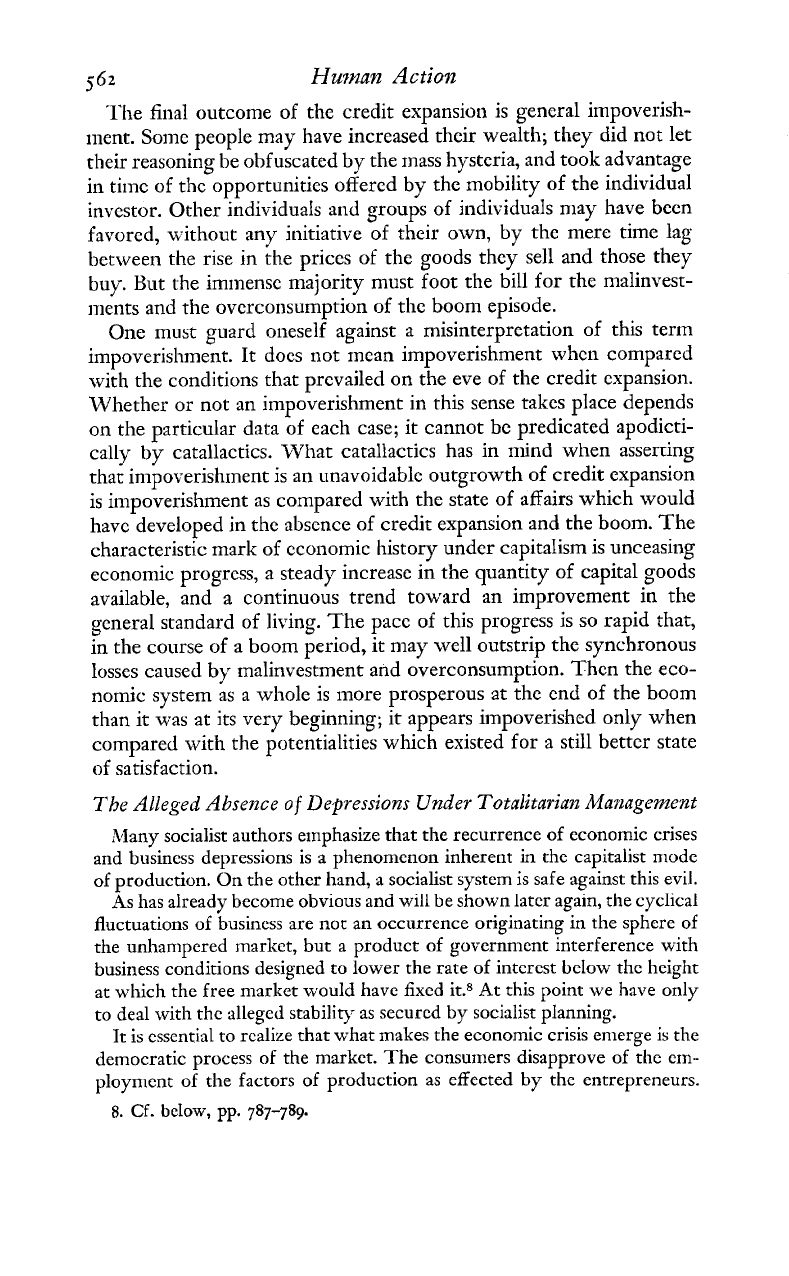
j62
Human
Action
The
final outcome of the credit expansion is gencral impoverish-
ment. Some people may have increased their wealth; they did not let
their reasoning be obfuscated by the mass hysteria, and took advantage
in time of the opportunities offered by the mobility of the individual
investor. Other individuals and groups of individuals may have been
favored, without any initiative of their own, by the mere time lag
between the rise in ;he prices of the goods they sell and those they
buy. But the immense majority must foot the bill for the malinvest-
ments and the overco~~sumption of the boom episode.
One must guard oneself against a misinterpretation of this term
impoverishment. It does not mean impoverishment whcn compared
with the conditions that prevailed on the eve of the credit expansion.
Whether or not an impoverishment in this sense takes place depends
on the particular data of each case; it cannot be predicated apodicti-
cally
by
catallactics. What catallactics
has
in
mind when asserting
that impoverishment is an unavoidablc outgrowth of credit expansion
is in~poverishment as compared with the state of affairs which would
have developed in the absence of credit expansion and the boom. The
characteristic mark of cconomic history under capitalism is unceasing
economic progress, a steady increase in the quantity of capital goods
available, and a continuous trend toward an improvement in the
general standard of living. The pace of this progress is so rapid that,
in the course of a boom period, it may well outstrip the synchronous
losses caused by rnalinvestment and overconsumption. Then the eco-
nornic system as a whole is more prosperous at the end of the boom
than it was at its very beginning; it appears
impoverished
only when
compared with the potentialities which existed for a still bettcr state
of satisfaction.
The Alleged Absence of Depressions Under Totalitarian Management
Many socialist authors emphasize that the recurrence of economic crises
and business depressions is
a
phenon~enon inherent in the capitalist mode
of production. On the other
hand,
a socialist system is safe against this evil.
As has already become obvious and will be shown later agaln, the cycl~cal
fluctuations of business are not an occurrence originating
in
the sphere of
the unhampered market, but a product of government interference with
business conditions designed to lower the rate of interest below the height
at
which the free market would have fixed it.8 At this point we have only
to
deal with the alleged stabiliv as secured by socialist planning.
It
is essential to realize that what makes the economic crisis emerge is the
democratic process of the market.
The
consumers disapprove of the em-
ployment of the factors of production as effected by the entrepreneurs.
8.
Cf.
below,
pp.
787-789.
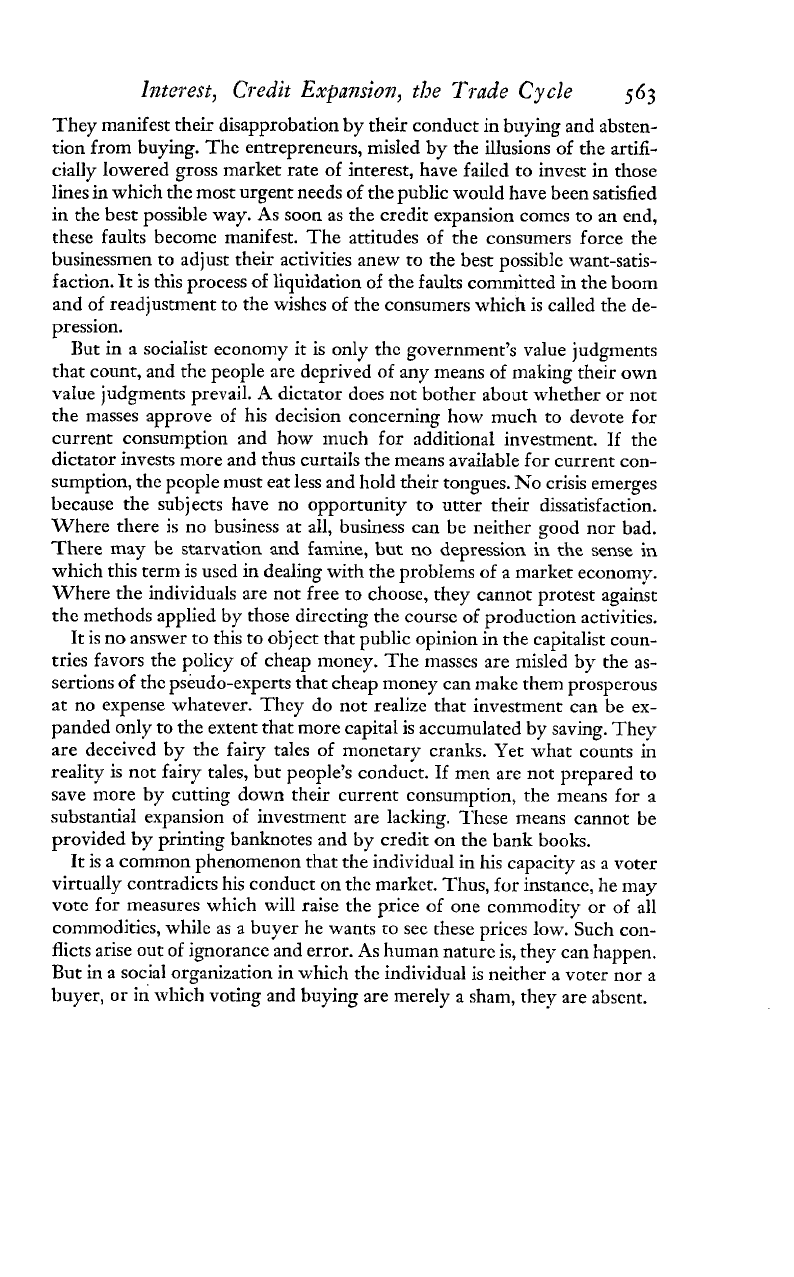
Irztc~est,
Credit
Expmsion,
the
Tmde
Cycle
563
They manifest their disapprobation by their conduct in buying and absten-
tion from buying. The entrepreneurs, misled by the illusions of the artifi-
cially lowered gross market rate of interest, have failed to invest in those
lines in which the most urgent needs of the public would have been satisfied
in the best possible way. As soon as the credit expansion comes to an end,
these faults become manifest. The attitudes of the consumers force the
businessmen to adjust their activities anew to the best possible want-satis-
faction.
It
is this process of liquidation of the faults committed in the boom
and of readjustment to the wishes of the consumers which is called the de-
pression.
But in a sociaIist economy it is only the government's value judgments
that count, and the people are deprived of any means of making their own
value judgments prevail.
A
dictator does not bother about whether or not
the masses approve of his decision concerning how much to devote for
current consumption and how much for additional investment. If the
dictator invests more and thus curtails the means available for current con-
sumption, the people must eat less and hold their tongues. No crisis emerges
because the subjects have no opportunity to utter their dissatisfaction.
Where there is no business at all, business can be neither good nor bad.
There may be starvation and famine, but
no
depression
in
the
sense in
which this term is used in dealing with the problems of
a
market economy.
Where the individuals are not free to choose, they cannot protest against
the methods applied by those directing the course of production activities.
It is no answer to this to object that public opinion in the capitalist coun-
tries favors the policy of cheap money. The masses are misled by the as-
sertions of the pseudo-experts that cheap money can make them prosperous
at no expense whatever. They do not realize that investment can be ex-
panded only to the extent that more capital is accumulated by saving. They
are deceived by the fairy tales of monetary cranks. Yet what counts in
reality is not fairy tales, but people's conduct. If men are not prepared to
save more by cutting down their current consumption, the means for
a
substantial expansion of investment are lacking. l'hcse means cannot be
provided by printing banknotes and by credit on the bank books.
It is a common phenomenon that the individual in his capacity as a voter
virtually contradicts his conduct on the market. Thus, for instance, he may
vote for measures which will raise the price of one commodity or of all
commodities, while as a buyer he wants to see these prices low. Such con-
flicts arise out of ignorance and error. As human nature is, they can happen.
But in a social organization in which the individual is neither a voter nor
a
buyer, or in which voting and buying are merely a sham, they are absent.
